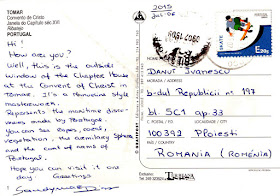 |
| 1818 Tomar - The castle of the Knights Templar |
Tomar lies in the most fertile region of Portugal and is one of country's historical jewels. Under the modern city lies the Roman city of Sellium. After the conquest of the region from the Moors in the Portuguese Reconquista, the land was granted in 1159 as a fief to the Order of the Knights Templar. Its Grand Master in Portugal, and Tomar's somewhat mythical founder, Gualdim Pais, laid in 1160 the first stone of the Castle and Monastery that would become the headquarters of the Order in Portugal. The Templars ruled from Tomar a vast region of central Portugal which they pledged to defend from Moorish attacks and raids.
 |
| 1819 Tomar - Convent of Christ The Chapter House Window |
After the Order was dissolved in the 14th century, its Portuguese branch was turned into the Knights of the Order of Christ, which supported Portugal's maritime discoveries of the 15th century. Henry the Navigator was the Governor of the Order, and it is believed that he used the resources and knowledge of the Order to succeed in his enterprises in Africa and in the Atlantic. The cross of the Order of Christ that was painted in the sails of the caravels that crossed the seas, and the Catholic missions in the new lands were under the authority of the Tomar clerics until 1514.
 |
| 1820 Tomar - Detail of the round church, view from the nave |
In the reign of Manuel I of Portugal the convent took its final form within the Manueline renaissance style. With the growing importance of the town as master of Portugal's overseas empire, the leadership of the Order was granted to the King by the Pope. King John III demilitarised the order, turning it into a more religious order with a rule based on that of Bernard of Clairvaux. The Convent of Tomar, originally conceived as a symbolic monument of the Reconquest, became, from the Manueline period, an inverse symbol: that of the opening of Portugal to external civilizations.
The castle of Tomar has an outer defensive wall and a citadel (alcáçova) with a keep inside. The Keep, a central tower of residential and defensive functions, was introduced in Portugal by the Templars, and the one in Tomar is one of the oldest in the country. When the town was founded, most of its residents lived in dwellings located inside the protective outer walls of the castle. Another novelty introduced in Portugal by the Templars are the round towers in the outer walls, which are more resistant to attacks.
The general shape of the Romanesque round church is modelled after similar structures in Jerusalem: the Dome of the Rock and the Church of the Holy Sepulchre. From the outside, it is a 16-side polygonal structure, with strong buttresses, round windows and a bell-tower. Inside, the round church has a central, octagonal structure, connected by arches to a surrounding gallery (ambulatory). The interior of the round church is magnificently decorated with late gothic/manueline sculpture and paintings, added during a renovation sponsored by King Manuel I starting in 1499.
During the administration of Prince Henry the Navigator, a gothic nave was added, thus turning the round church into a church apse. From the outside, the rectangular nave is covered by abundant Manueline motifs, including gargoyles, gothic pinnacles, statues and "ropes" that remind the ones used in the ships during the Age of Discovery, as well as the Cross of the Order of Christ and the emblem of King Manuel I, the armillary sphere. The so-called Window of the Chapter House (Janela do Capítulo), a huge window visible from the Saint Barbara Cloister in the Western façade of the nave, carries most of the typical Manueline motifs.
About the stamp
The stamp is part of the series Extreme Sports, about which I wrote here.
References
Convent of Christ (Tomar) - Wikipedia
Convent of Christ in Tomar - UNESCO official website
Sender: Sandra (direct swap)
Sent from Tomar (Santarém / Portugal), on 06.07.2015



No comments:
Post a Comment